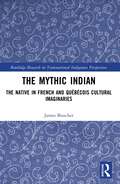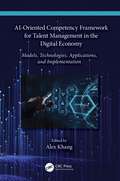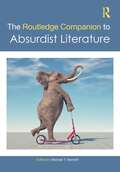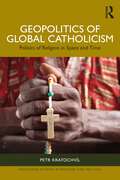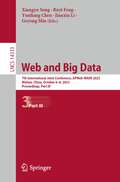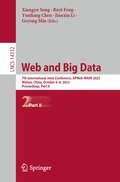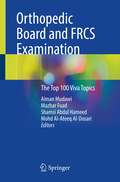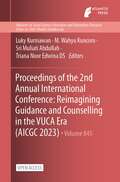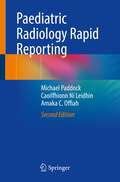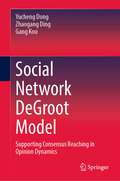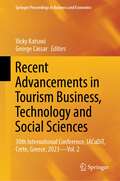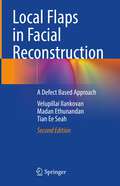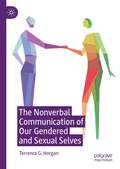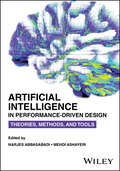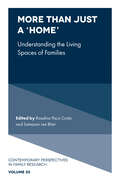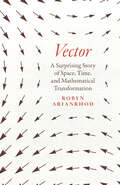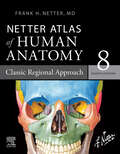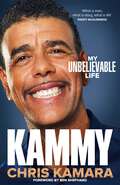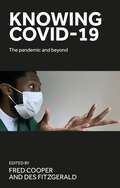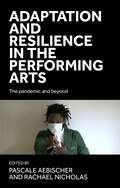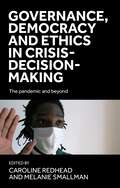- Table View
- List View
The Mythic Indian: The Native in French and Québécois Cultural Imaginaries (Routledge Research in Transnational Indigenous Perspectives)
by James BoucherThe Mythic Indian: The Native in French and Québécois Cultural Imaginaries charts a genealogy of French and Québécois visions of the Amerindian. Tracing an evolution of paradigms from the sixteenth century to present, it examines how the myths of the Noble, Ignoble, and Ecological Savage as well as the Vanishing Indian and Going Native inform a variety of discourses and ways of thinking about Québécois culture. By analyzing mythic depictions of the Native Figure that originate at first contacts, this book demonstrates that an inextricable link exists between discourses as disparate as literature and science.This book will be of interest to scholars in French Studies, Francophone Studies, Indigenous Studies, Hemispheric Studies, Social Sciences, and Literary Studies.
AI-Oriented Competency Framework for Talent Management in the Digital Economy: Models, Technologies, Applications, and Implementation
by Alex KhangIn the digital-driven economy era, an AI-oriented competency framework (AIoCF) is a collection to identify AI-oriented knowledge, attributes, efforts, skills, and experiences (AKASE) that directly and positively affect the success of employees and the organization. The application of skills-based competency analytics and AI-equipped systems is gradually becoming accepted by business and production organizations as an effective tool for automating several managerial activities consistently and efficiently in developing and moving the capacity of a company up to a world-class level.AI-Oriented Competency Framework for Talent Management in the Digital Economy: Models, Technologies, Applications, and Implementation discusses all the points of an AIoCF, which includes predictive analytics, advisory services, predictive maintenance, and automated processes, which help to make the operations of project management, personnel management, or administration more efficient, profitable, and safe. The book includes the functionality of emerging career pathways, hybrid learning models, and learning paths related to the learning and development of employees in the production or delivery fields. It also presents the relationship between skills taxonomy and competency framework with interactive methods using datasets, processing workflow diagrams, and architectural diagrams for easy understanding of the application of intelligent functions in role-based competency systems. By also covering upcoming areas of AI and data science in many government and private organizations, the book not only focuses on managing big data and cloud resources of the talent management system but also provides cybersecurity techniques to ensure that systems and employee competency data are secure.This book targets a mixed audience of students, engineers, scholars, researchers, academics, and professionals who are learning, researching, and working in the field of workforce training, human resources, talent management systems, requirement, headhunting, outsourcing, and manpower consultant services from different cultures and industries in the era of digital economy.
AI-Oriented Competency Framework for Talent Management in the Digital Economy: Models, Technologies, Applications, and Implementation
In the digital-driven economy era, an AI-oriented competency framework (AIoCF) is a collection to identify AI-oriented knowledge, attributes, efforts, skills, and experiences (AKASE) that directly and positively affect the success of employees and the organization. The application of skills-based competency analytics and AI-equipped systems is gradually becoming accepted by business and production organizations as an effective tool for automating several managerial activities consistently and efficiently in developing and moving the capacity of a company up to a world-class level.AI-Oriented Competency Framework for Talent Management in the Digital Economy: Models, Technologies, Applications, and Implementation discusses all the points of an AIoCF, which includes predictive analytics, advisory services, predictive maintenance, and automated processes, which help to make the operations of project management, personnel management, or administration more efficient, profitable, and safe. The book includes the functionality of emerging career pathways, hybrid learning models, and learning paths related to the learning and development of employees in the production or delivery fields. It also presents the relationship between skills taxonomy and competency framework with interactive methods using datasets, processing workflow diagrams, and architectural diagrams for easy understanding of the application of intelligent functions in role-based competency systems. By also covering upcoming areas of AI and data science in many government and private organizations, the book not only focuses on managing big data and cloud resources of the talent management system but also provides cybersecurity techniques to ensure that systems and employee competency data are secure.This book targets a mixed audience of students, engineers, scholars, researchers, academics, and professionals who are learning, researching, and working in the field of workforce training, human resources, talent management systems, requirement, headhunting, outsourcing, and manpower consultant services from different cultures and industries in the era of digital economy.
The Routledge Companion to Absurdist Literature (Routledge Literature Companions)
by Michael Y. BennettThe Routledge Companion to Absurdist Literature is the first authoritative and definitive edited collection on absurdist literature. As a field-defining volume, the editor and the contributors are world leaders in this ever-exciting genre that includes some of the most important and influential writers of the twentieth century, including Samuel Beckett, Harold Pinter, Edward Albee, Eugene Ionesco, Jean Genet, and Albert Camus. Ever puzzling and always refusing to be pinned down, this book does not attempt to define absurdist literature, but attempts to examine its major and minor players. As such, the field is indirectly defined by examining its constituent writers. Not only investigating the so-called “Theatre of the Absurd,” this volume wades deeply into absurdist fiction and absurdist poetry, expanding much of our previous sense of what constitutes absurdist literature. Furthermore, long overdue, approximately one-third of the book is devoted to marginalized writers: black, Latin/x, female, LGBTQ+, and non-Western voices.
The Routledge Companion to Absurdist Literature (Routledge Literature Companions)
by Michael Y. BennettThe Routledge Companion to Absurdist Literature is the first authoritative and definitive edited collection on absurdist literature. As a field-defining volume, the editor and the contributors are world leaders in this ever-exciting genre that includes some of the most important and influential writers of the twentieth century, including Samuel Beckett, Harold Pinter, Edward Albee, Eugene Ionesco, Jean Genet, and Albert Camus. Ever puzzling and always refusing to be pinned down, this book does not attempt to define absurdist literature, but attempts to examine its major and minor players. As such, the field is indirectly defined by examining its constituent writers. Not only investigating the so-called “Theatre of the Absurd,” this volume wades deeply into absurdist fiction and absurdist poetry, expanding much of our previous sense of what constitutes absurdist literature. Furthermore, long overdue, approximately one-third of the book is devoted to marginalized writers: black, Latin/x, female, LGBTQ+, and non-Western voices.
Geopolitics of Global Catholicism: Politics of Religion in Space and Time (Routledge Studies in Religion and Politics)
by Petr KratochvílGeopolitics of Global Catholicism uncovers the key trends in today’s Catholicism, providing an incisive analysis of its deep entanglement with national, regional, as well as global politics.This book offers an exciting exploration of five versions of local Catholicism(s) and sheds light on the various theo-political constellations that not only differ widely across these national contexts but also have global geopolitical consequences. It is built around a novel theoretical argument showing that Catholic geopolitics contains not only a spatial dimension (as classic geopolitical studies would have it) but also a temporal one. As a consequence, the Catholic role in the world cannot be simply understood as a result of the spatial expansion of the Church but rather as a result of the complex relationships between Catholicism and colonization, inculturation, backwardness, and modernization(s). To counter the lingering Eurocentrism of most studies of the Catholic Church, this book’s case studies explore Catholic geopolitics in five non-European contexts, focusing mainly on the Global South (plus the United States): Latin America (Brazil), North America (the United States), Asia (India and China), and Africa (the Democratic Republic of the Congo). These case studies also show that the successes and failures of Catholicism cannot be explained by a recourse to a single, top-down interpretation of Catholic geopolitics, but rather by exploring the various Catholic spatio-temporal constellations on the global, regional, and local levels. With the accelerating diversification of the Church and the growing role of the Global South, these local and regional influences gain further importance as they are likely to increasingly define the future of Catholicism.This book will be of utmost interest to scholars of International Relations, Religious Studies, Political Science, and Theology, as well as Geopolitics, especially to those studying the global rise of religion. Its accessible language will also appeal to the wider public beyond academia, especially those interested in global Christianity, as well as church leaders, and members of Catholic organizations.
Geopolitics of Global Catholicism: Politics of Religion in Space and Time (Routledge Studies in Religion and Politics)
by Petr KratochvílGeopolitics of Global Catholicism uncovers the key trends in today’s Catholicism, providing an incisive analysis of its deep entanglement with national, regional, as well as global politics.This book offers an exciting exploration of five versions of local Catholicism(s) and sheds light on the various theo-political constellations that not only differ widely across these national contexts but also have global geopolitical consequences. It is built around a novel theoretical argument showing that Catholic geopolitics contains not only a spatial dimension (as classic geopolitical studies would have it) but also a temporal one. As a consequence, the Catholic role in the world cannot be simply understood as a result of the spatial expansion of the Church but rather as a result of the complex relationships between Catholicism and colonization, inculturation, backwardness, and modernization(s). To counter the lingering Eurocentrism of most studies of the Catholic Church, this book’s case studies explore Catholic geopolitics in five non-European contexts, focusing mainly on the Global South (plus the United States): Latin America (Brazil), North America (the United States), Asia (India and China), and Africa (the Democratic Republic of the Congo). These case studies also show that the successes and failures of Catholicism cannot be explained by a recourse to a single, top-down interpretation of Catholic geopolitics, but rather by exploring the various Catholic spatio-temporal constellations on the global, regional, and local levels. With the accelerating diversification of the Church and the growing role of the Global South, these local and regional influences gain further importance as they are likely to increasingly define the future of Catholicism.This book will be of utmost interest to scholars of International Relations, Religious Studies, Political Science, and Theology, as well as Geopolitics, especially to those studying the global rise of religion. Its accessible language will also appeal to the wider public beyond academia, especially those interested in global Christianity, as well as church leaders, and members of Catholic organizations.
Web and Big Data: 7th International Joint Conference, APWeb-WAIM 2023, Wuhan, China, October 6–8, 2023, Proceedings, Part III (Lecture Notes in Computer Science #14333)
by Jianxin Li Geyong Min Xiangyu Song Ruyi Feng Yunliang ChenThe 4-volume set LNCS 14331, 14332, 14333, and 14334 constitutes the refereed proceedings of the 7th International Joint Conference, APWeb-WAIM 2023, which took place in Wuhan, China, in October 2023. The total of 138 papers included in the proceedings were carefully reviewed and selected from 434 submissions. They focus on innovative ideas, original research findings, case study results, and experienced insights in the areas of the World Wide Web and big data, covering Web technologies, database systems, information management, software engineering, knowledge graph, recommend system and big data.
Web and Big Data: 7th International Joint Conference, APWeb-WAIM 2023, Wuhan, China, October 6–8, 2023, Proceedings, Part II (Lecture Notes in Computer Science #14332)
by Jianxin Li Geyong Min Xiangyu Song Ruyi Feng Yunliang ChenThe 4-volume set LNCS 14331, 14332, 14333, and 14334 constitutes the refereed proceedings of the 7th International Joint Conference, APWeb-WAIM 2023, which took place in Wuhan, China, in October 2023. The total of 138 papers included in the proceedings were carefully reviewed and selected from 434 submissions. They focus on innovative ideas, original research findings, case study results, and experienced insights in the areas of the World Wide Web and big data, covering Web technologies, database systems, information management, software engineering, knowledge graph, recommend system and big data.
Orthopedic Board and FRCS Examination: The Top 100 Viva Topics
by Aiman Mudawi Mazhar Fuad Shamsi Abdul Hameed Mohd Al-Ateeq Al-DosariThis book focuses on the precise needs of candidates preparing for the viva part of the FRCS, Int-FRCS, and Orthopaedic Board Examinations. With more than 600 candidates annually sitting for these examinations this volume is meticulously crafted to empower aspiring orthopaedists to excel in it.Structured for effortless comprehension, the book is presented in a reader-friendly format that facilitates effective revision. Entirely written by experts who have successfully navigated these examinations its authorship contributes to make it an invaluable resource for aspirant orthopaedists.This practical yet comprehensive book covers high-yield topics essential for passing the exams while also equipping readers with strategies to confidently address even the most unconventional scenarios they may encounter during vivas. This practical resource provides a structured and unparalleled approach to empower aspiring orthopaedists to excel in the FRCS, Int-FRCS, and Orthopaedic Board Examinations.
Proceedings of the 2nd Annual International Conference: Reimagining Guidance and Counselling in the VUCA Era (Advances in Social Science, Education and Humanities Research #845)
This is an open access book. 2nd Annual International Conference (AIC) 2023! Annual International Conference (AIC) is an international conference hosted by the Guidance and Counseling Department, Faculty of Education and Teacher Trainings, Universitas Mercu Buana Yogyakarta, Indonesia. The chosen theme is “Reimagining Guidance and Counseling in the VUCA Era: Navigating Volatility, Uncertainty, Complexity, and Ambiguity in the Field of Education”. Believe that this seminar will provide valuable insights into the evolving landscape of education and the vital role of guidance and counseling in supporting students’ well-being and success amidst the challenges posed by VUCA.
Paediatric Radiology Rapid Reporting
by Michael Paddock Amaka C. Offiah Caoilfhionn Ní LeidhinThere is a narrow margin between pass and fail in the notably demanding Rapid Reporting component of the Fellowship of the Royal College of Radiologists (FRCR) Part 2B examination. This book provides readers with a comprehensive evaluation of paediatric radiographs, not only for those preparing for this examination but for all those who report them in their clinical practice. The overriding principle remains the same regardless of background – safe radiographic interpretation. Prospective candidates may have only had limited opportunity to report paediatric imaging, which may have been some time before they attempt the examination. Whilst other resources provide only a limited selection of paediatric radiographs, this book is solely dedicated to improving skill and knowledge in paediatric reporting. This text has been meticulously crafted to bridge any gaps in knowledge, while addressing deficiencies repeatedly identified in the FRCR Part 2B Examiners’ Reports in that “many candidates struggle with interpretation of paediatric imaging—even for common paediatric pathologies” and that “knowledge of normal appearances on paediatric plain images…was particularly poor in the Rapid Reporting”. This new edition has been extensively revised and contains 3 new tests. This unrivalled educational resource now comprises nearly 400 practice paediatric radiographs which is unique to the marketplace. The range of cases, from neonate to adolescent, deliver a sound knowledge of common paediatric fracture patterns and pathologies which enables readers to confidently differentiate between normal and abnormal. The much-lauded explanations accompanying these high-quality imaging tests remain robust and accurate, allowing candidates to maximise their preparation for all facets of the FRCR 2B examination and beyond. Foreword by Professor Derek Roebuck
Social Network DeGroot Model: Supporting Consensus Reaching in Opinion Dynamics
by Gang Kou Yucheng Dong Zhaogang DingThis book investigates the DeGroot model in social network contexts, and proposes the social network DeGroot (SNDG) model. Specifically, this book focuses on two core research problems in the SNDG model: (i) Social network structures to reach a stable state (consensus, polarization, or fragmentation); and (ii) the convergence rate to reach a stable state. Furthermore, the authors generalize the SNDG model in an uncertain context, showing the effects of interval opinions on the SNDG model. In this book, the authors also discuss the applications of the SNDG model to support group decision making, including consensus reaching through adding minimum interactions, trust relationships manipulations, and risk control issues in the social network. Apart from theoretical analysis, detailed experimental simulations with real and random data will be applied to validate our research.This book is the first to connect opinion dynamics, social network and group decision making. The resultsreported can help us understand the evolution of public opinions in social network contexts and provide new tools to support consensus reaching in group decision making.
Recent Advancements in Tourism Business, Technology and Social Sciences: 10th International Conference, IACuDiT, Crete, Greece, 2023 - Vol. 2 (Springer Proceedings in Business and Economics)
by Vicky Katsoni George CassarThe book features the second volume of the proceedings of the 10th International Conference of the International Association of Cultural and Digital Tourism (IACuDiT), with the theme “Recent Advancements in Tourism Business, Technology, and Social Sciences,” which was held from August 29 to 31, 2023, in Crete, Greece. It showcases the latest research on Tourism Business, Technology, and Social Sciences and presents a critical academic discourse on smart and sustainable practices in the tourism industry, stimulating future debates and advancing readers’ knowledge and understanding of this critical area of tourism business in the post-COVID-19 era. COVID-19 produced dramatic effects on the global economy, business activities, and people, with tourism being particularly affected. The book discusses the resulting digital transformation process in a range of areas, including its effect on the social sciences combined with special forms of tourism. This accelerated digitalizationencourages the emergence of new digital products and services based on the principle of flexibility. The book focuses on the knowledge economy and smart destinations, as well as new modes of tourism management and development, and includes chapters on emerging technologies such as the Internet of Things, artificial intelligence, big data, and robotics in connection with various tourism practices.
Local Flaps in Facial Reconstruction: A Defect Based Approach
by Velupillai Ilankovan Madan Ethunandan Tian Ee SeahWritten by three consultants with extensive skin cancer experience and international reputations for excellence, this book provides comprehensive practical solutions for defects in the head and neck region that clinicians are confronted with in day-to-day practice. The first edition of the “local flaps in facial reconstruction- a defect base approach” was published nearly four years ago and has since been well received around the world and translated into other languages. This second edition is intended to facilitate the decision-making process and provide practical,step-by-step guidance on reconstructing specific defects in the facial region.The frequency of skin cancer continues to rise around the globe, and clinicians with various backgrounds are involved in the care of these patients. In this book, new procedures are described and “old” ones re-evaluated. The current edition has been extensively updated with new text and diagrams so as to provide comprehensive practical solutions for frequently encountered facial defects. Color diagrams and clinical photographs have been included where necessary to provide additional details. The original ethos of creating a text that can be used in everyday practice, while also including personal comments, is maintained.Given the scope, the book is ideal for use by clinicians and trainees in daily practice, and will help to achieve excellent cosmetic outcomes in this aesthetically sensitive part of the body.
The Nonverbal Communication of Our Gendered and Sexual Selves
by Terrence G. HorganThis book provides a comprehensive guide to the latest research on the nonverbal cues that signal our biological sex, gender, and sexual orientation to others, as well as our sexual/romantic interest in others. Crucially, it is a volume which incorporates critical perspectives which help to tackle the short-comings associated with the predominant focus on cis-gender, heterosexual individuals . It underscores how specific cues work in conjunction with other cues during the communication of our gendered and sexual selves, and how various factors (cultural, contextual, social, personality variables) impact that process. It also addresses common misconceptions including the notion that the romantic landscape has become more sexualized and predominantly technology driven. This book highlights that we still tend to communicate a romantic interest in each other in quite traditional places, such as school, home, and social events, using tried-and-true nonverbal cues, like gazing and smiling. Across six chapters readers will learn about the cues to our gendered and sexual selves, which exist in our facial and bodily movements, dress, personal artifacts, gestures, body odor, vocal characteristics, touch, and posture, amongst others. This engaging work presents historical and contemporary research findings that will appeal to students and scholars of nonverbal communication, communication studies, the psychology of gender, and sexuality studies.
Artificial Intelligence in Performance-Driven Design: Theories, Methods, and Tools
by Narjes Abbasabadi Mehdi AshayeriA definitive, interdisciplinary reference to using artificial intelligence technology and data-driven methodologies for sustainable design Artificial Intelligence in Performance-Driven Design: Theories, Methods, and Tools explores the application of artificial intelligence (AI), specifically machine learning (ML), for performance modeling within the built environment. This work develops the theoretical foundations and methodological frameworks for utilizing AI/ML, with an emphasis on multi-scale modeling encompassing energy flows, environmental quality, and human systems. The book examines relevant practices, case studies, and computational tools that harness AI’s capabilities in modeling frameworks, enhancing the efficiency, accuracy, and integration of physics-based simulation, optimization, and automation processes. Furthermore, it highlights the integration of intelligent systems and digital twins throughout the lifecycle of the built environment, to enhance our understanding and management of these complex environments. This book also: Incorporates emerging technologies into practical ideas to improve performance analysis and sustainable design Presents data-driven methodologies and technologies that integrate into modeling and design platforms Shares valuable insights and tools for developing decarbonization pathways in urban buildings Includes contributions from expert researchers and educators across a range of related fields Artificial Intelligence in Performance-Driven Design is ideal for architects, engineers, planners, and researchers involved in sustainable design and the built environment. It’s also of interest to students of architecture, building science and technology, urban design and planning, environmental engineering, and computer science and engineering.
More than just a ‘Home’: Understanding the Living Spaces of Families (Contemporary Perspectives in Family Research #25)
by Rosalina Pisco Costa and Sampson Lee BlairOver time and space, sociology has given varying importance to the study of the house. The house is often a locus of special attention when a couple is formed, and the investments made in a neolocal residence constitute a complex social fact. There is much to be known about the importance of and the relationships between home and family. Rooted in diverse theoretical approaches and multi-method research projects, this edited collection provides a broad understanding of the house as a plural, diverse and meaningful space. Paying attention to specific occupational, gender and age patterns in home spaces, chapters also consider how digital technologies, including the 'smart home', as well as the recent COVID-19 pandemic and the subsequent 'turn to home' have impacted family life on a micro level. Exploring relationships between the family and the material and symbolic dimensions of the home, authors discuss the trajectory and composition of the household, the gendered division of labor, work-family and education-family dynamics, care work and more. Considering the ways in which a family socially constructs a home, this is a much-needed investigation into how the house, its architecture, spatial arrangements and internal and external divisions shape and reshape family relationships in the face of constant challenges and change.
More than just a ‘Home’: Understanding the Living Spaces of Families (Contemporary Perspectives in Family Research #25)
by Sampson Lee Blair Rosalina Pisco CostaOver time and space, sociology has given varying importance to the study of the house. The house is often a locus of special attention when a couple is formed, and the investments made in a neolocal residence constitute a complex social fact. There is much to be known about the importance of and the relationships between home and family. Rooted in diverse theoretical approaches and multi-method research projects, this edited collection provides a broad understanding of the house as a plural, diverse and meaningful space. Paying attention to specific occupational, gender and age patterns in home spaces, chapters also consider how digital technologies, including the 'smart home', as well as the recent COVID-19 pandemic and the subsequent 'turn to home' have impacted family life on a micro level. Exploring relationships between the family and the material and symbolic dimensions of the home, authors discuss the trajectory and composition of the household, the gendered division of labor, work-family and education-family dynamics, care work and more. Considering the ways in which a family socially constructs a home, this is a much-needed investigation into how the house, its architecture, spatial arrangements and internal and external divisions shape and reshape family relationships in the face of constant challenges and change.
Vector: A Surprising Story of Space, Time, and Mathematical Transformation
by Robyn ArianrhodA celebration of the seemingly simple idea that allowed us to imagine the world in new dimensions—sparking both controversy and discovery. The stars of this book, vectors and tensors, are unlikely celebrities. If you ever took a physics course, the word “vector” might remind you of the mathematics needed to determine forces on an amusement park ride, a turbine, or a projectile. You might also remember that a vector is a quantity that has magnitude and (this is the key) direction. In fact, vectors are examples of tensors, which can represent even more data. It sounds simple enough—and yet, as award-winning science writer Robyn Arianrhod shows in this riveting story, the idea of a single symbol expressing more than one thing at once was millennia in the making. And without that idea, we wouldn’t have such a deep understanding of our world. Vector and tensor calculus offers an elegant language for expressing the way things behave in space and time, and Arianrhod shows how this enabled physicists and mathematicians to think in a brand-new way. These include James Clerk Maxwell when he ushered in the wireless electromagnetic age; Einstein when he predicted the curving of space-time and the existence of gravitational waves; Paul Dirac, when he created quantum field theory; and Emmy Noether, when she connected mathematical symmetry and the conservation of energy. For it turned out that it’s not just physical quantities and dimensions that vectors and tensors can represent, but other dimensions and other kinds of information, too. This is why physicists and mathematicians can speak of four-dimensional space-time and other higher-dimensional “spaces,” and why you’re likely relying on vectors or tensors whenever you use digital applications such as search engines, GPS, or your mobile phone. In exploring the evolution of vectors and tensors—and introducing the fascinating people who gave them to us—Arianrhod takes readers on an extraordinary, five-thousand-year journey through the human imagination. She shows the genius required to reimagine the world—and how a clever mathematical construct can dramatically change discovery’s direction.
Netter Atlas of Human Anatomy: English And Latin Edition (Netter Basic Science)
by Frank H. NetterFor students and clinical professionals who are learning anatomy, participating in a dissection lab, sharing anatomy knowledge with patients, or refreshing their anatomy knowledge, the Netter Atlas of Human Anatomy illustrates the body, region by region, in clear, brilliant detail from a clinician’s perspective. Unique among anatomy atlases, it contains illustrations that emphasize anatomic relationships that are most important to the clinician in training and practice. Illustrated by clinicians, for clinicians, it contains more than 550 exquisite plates plus dozens of carefully selected radiologic images for common views. Presents world-renowned, superbly clear views of the human body from a clinical perspective, with paintings by Dr. Frank Netter as well as Dr. Carlos A. G. Machado, one of today’s foremost medical illustrators. Content guided by expert anatomists and educators: R. Shane Tubbs, Paul E. Neumann, Jennifer K. Brueckner-Collins, Martha Johnson Gdowski, Virginia T. Lyons, Peter J. Ward, Todd M. Hoagland, Brion Benninger, and an international Advisory Board. Offers region-by-region coverage, including muscle table appendices at the end of each section and quick reference notes on structures with high clinical significance in common clinical scenarios. Contains new illustrations by Dr. Machado including clinically important areas such as the pelvic cavity, temporal and infratemporal fossae, nasal turbinates, and more. Features new nerve tables devoted to the cranial nerves and the nerves of the cervical, brachial, and lumbosacral plexuses. Uses updated terminology based on the second edition of the international anatomic standard, Terminologia Anatomica, and includes common clinically used eponyms. Provides access to extensive digital content: every plate in the Atlas?and over 100 bonus plates including illustrations from previous editions?is enhanced with an interactive label quiz option and supplemented with "Plate Pearls" that provide quick key points and supplemental tools for learning, reviewing, and assessing your knowledge of the major themes of each plate. Tools include over 300 multiple choice questions, videos, 3D models, and links to related plates. Own your own personal copy of the world-famous Netter Atlas of Human Anatomy! This well-loved title, now in 8th edition, is available in multiple options. Choose the one best for you: • Netter Atlas of Human Anatomy: Classic Regional Approach—described above • Netter Atlas of Human Anatomy: A Systems Approach—Same content as the classic regional approach, but organized by organ systems. • Netter Atlas of Human Anatomy: Classic Regional Approach with Latin terminology All options contain the same table information and same 550+ illustrated plates painted by clinician artists, Frank H. Netter, MD, and Carlos Machado, MD.
Kammy: The Funny and Moving Autobiography by the Broadcasting Legend
by Chris KamaraForeword by Ben Shephard‘Everyone loves Kammy . . . Full of humour and endless blunders’ – The Times'What a man, what a life, what a story, and what a great read' – Paddy McGuinnessPresenter, commentator, (sometimes masked) singer, footballer, manager and campaigner, Kammy has done it all. His irrepressible enthusiasm – and a couple of legendary gaffes on Sky Sports – have seen him become broadcasting royalty.Now Kammy reveals all in this funny and moving autobiography. What happens when you double cross José Mourinho? What it’s like to play with Vinnie Jones? Who comes off better: Kammy or a rampaging gorilla? How did Kammy end up releasing his own top-ten record? What's the real story behind his infamous line, 'I don't know, Jeff!'?But despite the crazy tales, it hasn't all been plain sailing. Kammy had a tough upbringing, faced racism during his playing career and has, in recent years, dealt with a rare brain condition – apraxia – that has affected his speech and seen him say goodbye to Sky Sports. Relating his battle against the condition, Kammy shows how he’s met every challenge with courage, determination and his infectious smile.Packed with hilarious stories and featuring a cast of famous names, from Elton John to Channing Tatum, this is a book about friendship, courage and why it's always important to have a good laugh.'A talented (and daft) lad from the Boro who has entertained the nation for decades, on and off the pitch. So get the tissues ready – this book will make you laugh and cry in equal measure' – Steph McGovern
Knowing COVID-19: The pandemic and beyond (The pandemic and beyond)
by Fred Cooper and Des FitzgeraldKnowing COVID-19 demonstrates how researchers in the humanities shone a light on some of the many hidden problems of COVID-19, in the very depths of the pandemic crisis. Drawing on eight COVID-19 research projects, the volume shows how humanities researchers, alongside colleagues in the clinical and life sciences, addressed some of the major critical unknowns about this new infectious disease – from the effects of racism to the risks of deploying shame; from how to design an effective instructional leaflet to how to communicate effectively to bus passengers. Across eight novel case studies, the book showcases how humanities research during a pandemic is not only about interpreting the crisis when it has safely passed, but how it can play a vital, collaborative and instrumental role as events are still unfolding.
Adaptation and resilience in the performing arts: The pandemic and beyond (The pandemic and beyond)
by Pascale Aebischer Rachael NicholasThis book offers insights into some of the digital innovations, structural adaptations and analogue solutions that enabled live performance in the UK to survive through the COVID-19 pandemic. It provides evidence of values-led policies and practices that have improved the wellbeing of the creative workforce and have increased access to live performance. Through sections that address digital innovations, workforce resilience and programming live performances outdoors and in community settings, this book provides practical insights into the challenges live performance faced during the pandemic. It shows how, in order to survive, individuals and companies within the sector drew on the creativity and resourcefulness of its workforce, and on new and existing networks. In these accounts, the pandemic functioned as catalyst for technological innovations, stock-taking regarding exploitative industry structures, and a re-valuing of the role of live performance for community-building.
Governance, democracy and ethics in crisis-decision-making: The pandemic and beyond (The pandemic and beyond)
by Caroline Redhead Melanie SmallmanThis book is a powerful addition to a developing literature informed by arts and humanities research carried out during the COVID-19 pandemic. Investigating the impacts of crisis governance and decision-making on people and populations, the book brings together microbial organisms and humans, children and data, decision-making and infection prevention, publics and process, global vaccine distribution and citizens’ juries. Through its eight chapters, the book stimulates broadly-drawn discussions about exceptional executive powers in an emergency, the role of trust, and the importance of the principles of good governance – such as selflessness, ethics, integrity, accountability and honesty in leadership. The lessons drawn out in this book will support future decision-makers in both ordinary times and extra-ordinary emergencies.
